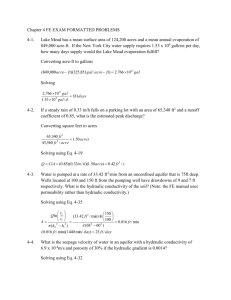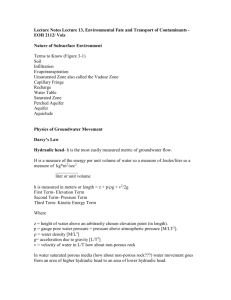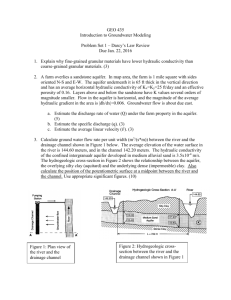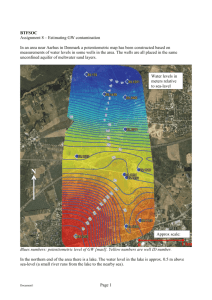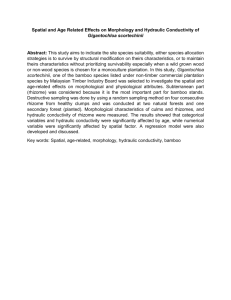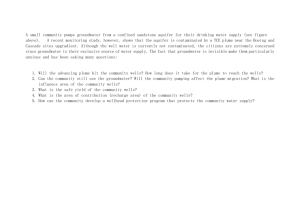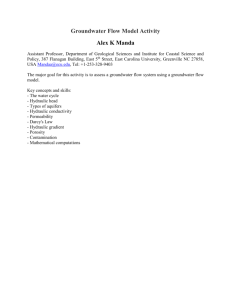ps1
advertisement
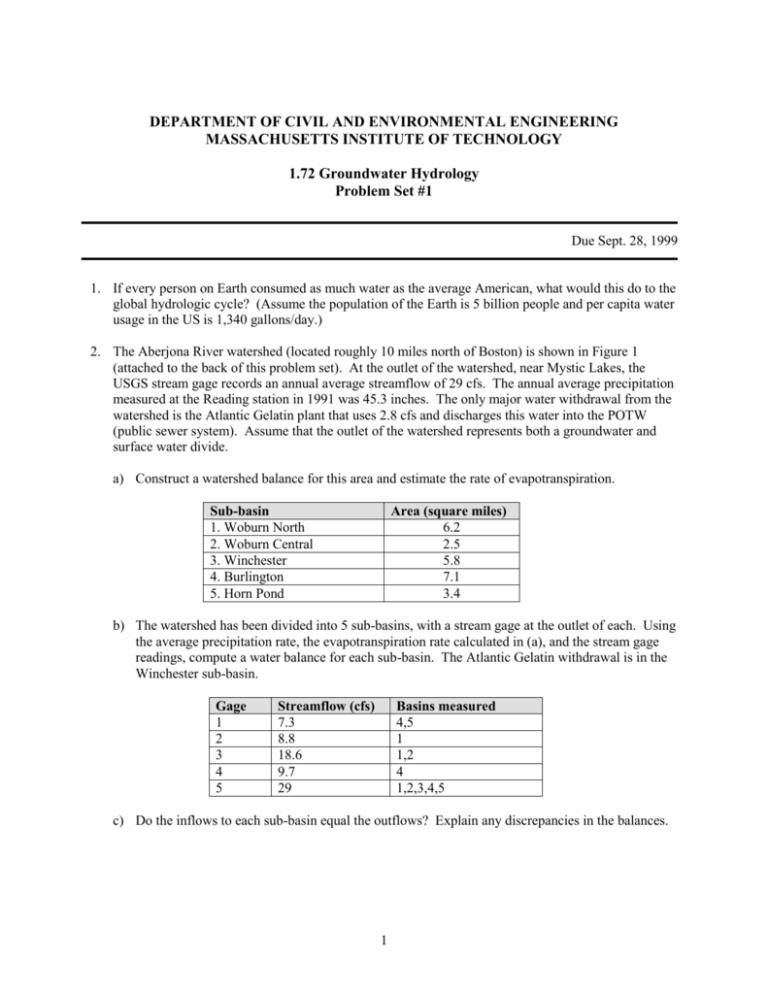
DEPARTMENT OF CIVIL AND ENVIRONMENTAL ENGINEERING MASSACHUSETTS INSTITUTE OF TECHNOLOGY 1.72 Groundwater Hydrology Problem Set #1 Due Sept. 28, 1999 1. If every person on Earth consumed as much water as the average American, what would this do to the global hydrologic cycle? (Assume the population of the Earth is 5 billion people and per capita water usage in the US is 1,340 gallons/day.) 2. The Aberjona River watershed (located roughly 10 miles north of Boston) is shown in Figure 1 (attached to the back of this problem set). At the outlet of the watershed, near Mystic Lakes, the USGS stream gage records an annual average streamflow of 29 cfs. The annual average precipitation measured at the Reading station in 1991 was 45.3 inches. The only major water withdrawal from the watershed is the Atlantic Gelatin plant that uses 2.8 cfs and discharges this water into the POTW (public sewer system). Assume that the outlet of the watershed represents both a groundwater and surface water divide. a) Construct a watershed balance for this area and estimate the rate of evapotranspiration. Sub-basin 1. Woburn North 2. Woburn Central 3. Winchester 4. Burlington 5. Horn Pond Area (square miles) 6.2 2.5 5.8 7.1 3.4 b) The watershed has been divided into 5 sub-basins, with a stream gage at the outlet of each. Using the average precipitation rate, the evapotranspiration rate calculated in (a), and the stream gage readings, compute a water balance for each sub-basin. The Atlantic Gelatin withdrawal is in the Winchester sub-basin. Gage 1 2 3 4 5 Streamflow (cfs) 7.3 8.8 18.6 9.7 29 Basins measured 4,5 1 1,2 4 1,2,3,4,5 c) Do the inflows to each sub-basin equal the outflows? Explain any discrepancies in the balances. 1 3. Lake Cylinder has recently been annexed to the Octagon Forest National Recreation Area (Lake Parabola is the central attraction of the forest). In order to set boating license prices, the National Forest Service wishes to characterize the height of the lake over time. Lake Cylinder is a perfectly circular lake with a flat bottom. A h(t) r a) Set up an equation describing the height of the lake over time given a constant inflow Q and an initial lake height of ho. Solve for h(t) and plot the result for r = 10 m, Q = 10 m3/day, and ho = 1 m. b) Your supervisor pointed out that you have neglected evaporation in your conceptual model of Lake Cylinder. Assume that evaporation occurs over the area of the lake at rate e, and solve for h(t) as before. Plot the results for the values given in part (a) and e = 0.03 m/day. c) Try to determine the steady state solution for the lake height with inflow and evaporation (Set the time derivative to zero). Explain the meaning of your answer. d) Now consider inflow, evaporation, and seepage into underlying soils. Use the same seepage model as in the lecture notes (for Lake Parabola). The seepage volume flux is equal to a constant times the product of the depth of the lake and the area of the lake. What is the steady state solution in this case and why is it different from the answer in part (c) ? 4. Using reasonable values for pressure and groundwater velocity (look in a groundwater textbook), show why the kinetic term of the Bernoulli equation (1) may be neglected for groundwater systems. P v2 z constant w g 2g (1) 5. Given the following observations of the piezometric heads in three observation wells: Well x-coordinate (m) y-coordinate (m) Piezometric head (m) A 0 0 10 B 300 0 11.5 C 0 200 8.4 Assume the wells measure a homogeneous, isotropic, confined aquifer with constant thickness b = 20 m, effective porosity n = 0.2, and hydraulic conductivity K = 15 m/day. Approximate the piezometric surface between the wells as a plane. 2 a) Find the hydraulic gradient (magnitude and direction). b) Find the total discharge in the aquifer, per unit width. c) Assume this same aquifer is anisotropic with conductivity values in the matrix below. Determine the specific discharge, q, and the angle, between q and the hydraulic gradient. 20 6 K 6 10 6. Three piezometers (A, B, and C) are located 1000 m apart (in a line) in an unconfined aquifer. Fill in the blank spaces in the table below. Calculate the pressure heads and elevation heads at the base of the piezometers. Piezometer Ground surface (msl) (m) Depth of piezometer (m) Depth to water (m) Pressure head (m) Elevation head (m) Total head (m) Hydraulic gradient (m/m) A 450 B 435 C 430 70 50 27 53 335 400 7. Professor I.M. Farcy of MIT insists that under the MIT campus, the viscosity of groundwater is 5 times that of typical water, and furthermore, that the density of water is 5 times that of typical water. Assume that the water under the Harvard campus is typical and that the gravitational constant is the same at MIT and Harvard. Does Darcy’s Law predict different groundwater fluxes at MIT and Harvard? Explain. 8. In the heterogeneous system shown to the right, 1-D groundwater flow is perpendicular to layers of varying hydraulic conductivity. q a) The flow across the system (q) is 1 m/day. Using Darcy’s Law, find the change in head (h) across each layer. What is the total change in head across the entire system? h1 h2 K1 b1 K2 b2 h3 K3 b3 q K1= 20 m/day; K2 = 5 m/day; K3 = 10 m/day b1= 10 m ; b2 = 20 m ; b3 = 30 m b) Find the effective hydraulic conductivity (Kfor an equivalent homogeneous system, that is, a system with the same total gradient (from part a) and flow rate as the heterogeneous system. 3 c) Following the same procedures you used in parts (a) and (b) write a general expression for Kfor a heterogeneous system with i = 1,2,…m layers of thickness bi and with hydraulic conductivity Ki. 9. Now consider a heterogeneous system in which groundwater flow is parallel to layers of varying hydraulic conductivity. The specific discharge (q) is 1 m/day. K1 = 15 m/day b1 = 10 m q K2 = 10 m/day b2 = 20 m K3 = 5 m/day b3 = 10 m L = 100 m a) Calculate the total flow per unit width, QT , for this system where: QT qB qb1 b2 b3 Q1 Q2 Q3 b) Using QT and Darcy’s Law for each layer, find the gradient (h/x) of this system. Remember: Qi q bi K i h x bi (2) i 1,2,3 c) Find the effective hydraulic conductivity ( K ) for an equivalent homogeneous system. d) Write a general expression for K for a heterogeneous system with i = 1,2,…m layers of thickness bi and with hydraulic conductivity Ki. (Hint: use the relationship between q and QT to relate q in the equivalent system to q in the individual layers.) 10. Flow in a valley takes place as shown in the figure below. The formation in the valley has a hydraulic conductivity of 400 ft/day and a porosity of 0.25. The difference in water levels in the two wells shown is 1 ft. Between the observation wells, the average depth is 100 ft. a) Determine the rate of flow per mile width of the aquifer. b) How long will it take the groundwater to travel from the head of the valley to the stream bank? 4 11. Two observation wells have been constructed in the confined aquifer shown below. If the flow rate (Q) is 0.01 m3/hr/unit width, determine K2. What is the effective hydraulic conductivity (K) for this system? 5m 20 m K1 = 15 m/day 300 m 2.5 m K2 = ? K3 = 10 m/day 600 m 300 m 5 Figure 1: Sub-basins of the Aberjona River Watershed (Durrant, 1991) 6
